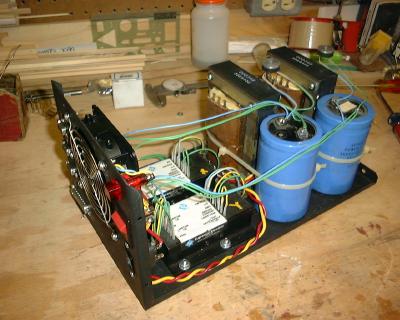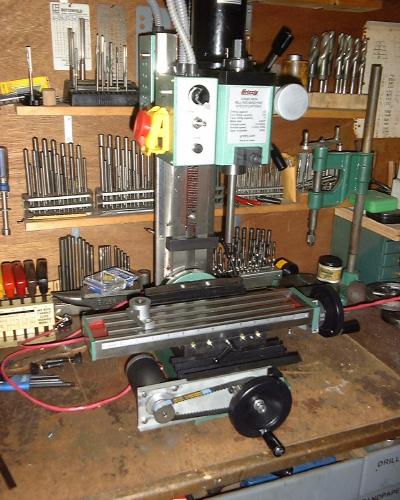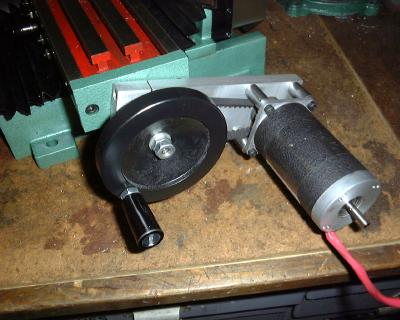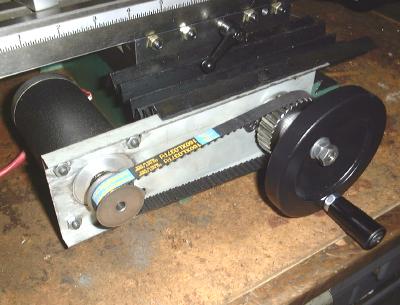
Some time ago I started a CNC project using a Sherline minature milling machine for CNC. See sherline.htm for some photos. Although the Sherline is a fine small mill, I wanted another, bigger mill as well.
After some delibration I decided to buy a new Grizzley Mini Mill model 8689. Like all of the imported machinery, it has its problems, but for US\$495 it is a good buy.
On the whole I think its a nice little machine. In general the 'fit and finish' is quite nice. All the machined surfaces have a good finish, things operate smoothly, etc.
It was well packed, well sloshed in some kind of presertive oil but it cleaned up eaisly.
The DC motor is very smooth, operates from a very slow speed where you can count the revs. I just made a simple plough cut with a 3/8" mill and it seemed to handle it with no strain. The motor is a bit noisy- about like a vaccuum cleaner.
It came with more accessories than I expected- 2 MT3 collets, 3/8" and 1/2", a drill chuck and shank, all the wrenches for every nut, a couple T-nuts, etc. The T-nut however is metric, and there were no bolts to fit it.
There is no quill feed, the entire head moves up and down on a V-way, It is driven by a rack and pinion with a 3 spoke hand wheel like a drill press. There is an adjustable stop you can set under the head to retun to a fixed position. I dont think a leadscrew conversion to the head will be practical. I'm going to continue as a 2D system, plan to operate the head manually. This will work well for my needs, but may not be suitable to many.
The X and Y screws can only be called bizzare- they are 16 tpi, but the collars are calibrated in 123 divisons. The divisions are labeled as .001", but in fact are .0005" and the numbers should read to 6 instead of 12. I wonder if the collars were made for a lathe to measure diameter instead of radius? For my use this wont matter but if someone bought this thing for manual use it would be very screwy to use.
There is VERY little room for a ball nut under the table. Unless I do some serious carving away I will be limited to a ball nut with an OD of just about .750". The only screws I find that small are only 1/4" thread, and that seems way to small for a lead screw.
So, in sum its a nice LITTLE machine.
It was just a few minutes work to chuck the plate on a 4 jaw and face off the .005. Someone without a big lathe could have simply filed off the excess- since it was simply to create a clearance it did not need to be accurately machined.
I also decided to hand scrape the ways for the table. This was not necessary, the mill was OK as it shipped, but I wanted to make it as good as possible, and a friend of mine had the tools and experience, and he offered to demo it.
I decided to use the leadscrews just as they came with the machine. There is about .003 to .004" backlash and I can live with that by some care in programming. As the screws wear I may have to do something else- my thought now is to try making a Moglice nut for it.
I built my own driver using some surplus chopper driver modules I also got at a flea market for $10. Following is a photo of the controller box.
 |
Here are a couple general photos of the mill with the motors attached.
 |
 |
And a close up of the X and Y motor mount. Note the Y mount was made of thin sheet metal with a formed edge for stiffness, because the motor shaft was to short to allow a thicker plate.
 |
 |
I decided to sell the Grizzley and move on to a bigger machine. Although it is cast iron, and slightly bigger than my Sherline, it is not enough bigger for me to keep both machines.